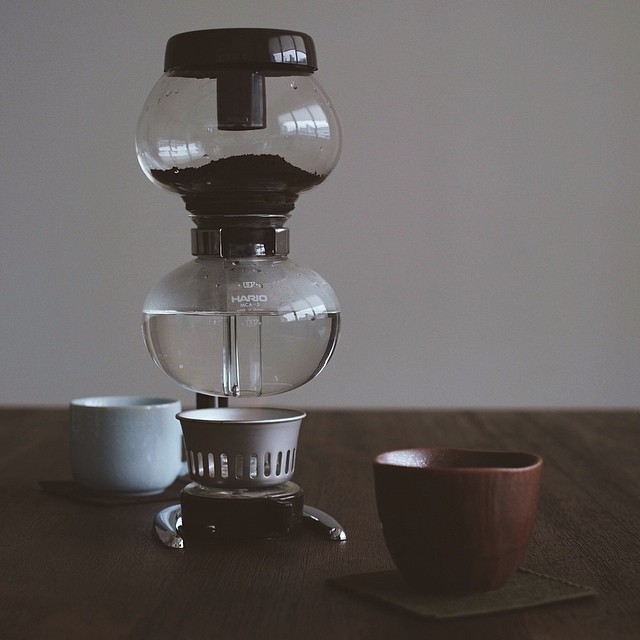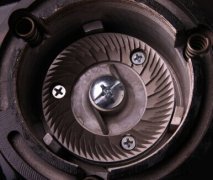Characteristics of siphon pot for making coffee Japanese coffee utensils
After 2003, the "third wave" of boutique coffee jumped, leading to the revival of follicular black coffee. Hand brewing and siphon pots have become the necessary wardrobe for the fashion of "third wave" boutique coffee in Europe and the United States. However, the skills of hand brewing and siphon pots are really very different. If you are lazy people who love good coffee and don't want to hurt your nerves, you might as well enjoy good coffee with your clever domestic product, the Aibeicong filter Cup (Abid Clever Dripper).
Siphon pot revival
Siphon pot is the most classic brewing method in early cafes in Taiwan, which has been popular for at least half a century, but after 1990, there was an Italian coffee craze in Taiwan. Starbucks, the leader of the "second wave" of boutique coffee in 1998, entered Taiwan and ignited the new fashion of latte and cappuccino, which dealt a heavy blow to the old siphon pot cafe. Black coffee has changed from prosperity to decline, and it has almost become the memory of the older generation of coffee people.
In recent years, siphon teapot has been replaced by hand in Japan and Taiwan. It is only because the glass material of the siphon kettle is fragile, the filter cloth is easy to stink, and another heat source such as gas stove, halogen lamp or alcohol lamp is needed, which is far less convenient and mobile than manual flushing.
However, the siphon pot still has unique advantages, such as the temperature of the extraction water is easy to control, the quality of bubble cooking is more stable than that of hand cooking, and the taste spectrum is rich and thick. Although the process of the siphon pot is more complicated, it is almost impossible to replace the siphon pot completely by hand. after all, there are a large number of nostalgic siphon fans in Taiwan, who indulge in trivial details and myths and enjoy the boundless charm of the siphon pot.
The siphon pot originated in Europe.
The history of the siphon pot is more than 70 years earlier than that of hand flushing. From 1830 to 1840, Loeff in Berlin, Germany, first invented the siphon pot extraction method made of glass and double pots, which was continuously improved and flourished in France, Britain, Germany and other countries.
After 1960, the United States invented the electric trickling filter pot, which was convenient and convenient, and gradually eliminated the hand flushing pot, siphon kettle and mocha pot in Europe and the United States, but the Japanese are still infatuated with the simple siphon pot and hand kettle and carry it forward, so there are still many coffee fans today. mistakenly believe that siphon pot and hand flush are Japanese inventions. In fact, both originated in Europe.
Siphon pot filter
The siphon pot kit, which includes a lower pot, an upper pot, a filter (metal or ceramic), a filter cloth or filter paper, a mixing rod and a gas stove or alcohol lamp, is more complex than a manual kit. The filter of the siphon pot is worth mentioning. The traditional filter is made of metal, but a few years ago, Kono in Japan launched a curved ceramic filter, which caused a lot of topic. Some people think that the siphon pot soaked by ceramic filter has a smoother and softer flavor and is not easy to appear abrupt taste spectrum, while the siphon pot soaked by traditional metal filter has more personality and larger amplitude. But some people think that there is no difference between the two kinds of filters, which is purely psychological.
In addition to the different materials, the appearance of the two filters is also very different, the metal filter is very flat, but the ceramic filter is a raised arc, the attached filter cloth, if it is the original Kono, the fabric is very meticulous, especially the sewing edge on the back is very neat, bubbles are less likely to be bubbled when cooking, which can reduce the interference of water flow and may result in a milder taste. But the price is not small, the price is several times that of the metal filter.
The filter of the siphon pot is wrapped in a piece of filter cloth, and some people think that it is too troublesome to clean the filter cloth after soaking. The siphon pot filter paper arises at the historic moment, which needs to be matched with a special combined filter. The filter paper is thrown away after use, which is very convenient, but it will occasionally seep into the fine coffee grounds after soaking. At present, the traditional metal filter is still the most popular, and few people use Kono arc filter and filter paper filter.
Principle of making coffee with siphon pot
The lower pot of the siphon can be called a capacity pot, which is spherical and marked with several cups of water scale. The upper pot is cylindrical, which can be called the extraction pot, and its base has a glass tube that leads directly to the lower pot, while the filter covered with filter cloth or filter paper is closely laid on the glass tube at the base of the upper pot to filter coffee grounds.
When the water in the lower pot is heated, it produces steam and pressure, which pushes the hot water in the lower pot from the glass tube to the upper pot, and begins to brew the coffee powder in the pot. After the extraction, remove the fire source, at this time the lower pot has been a semi-vacuum, and lost the upward thrust, the lower pot then sucked down the coffee liquid from the upper pot, and the coffee grounds were blocked on the filter cloth of the upper pot to complete the extraction. Siphon pot (Siphon Pot) is also called siphon pot (Vacuum Pot).
The siphon pot is like going up the hill, and the hand is like going down the hill.
The biggest advantage of the siphon pot is that the lower pot can be raised to the water temperature of the upper pot, and the fire control technique can be used to keep it in the range of 86 ℃ ~ 92 ℃ at low temperature or 88 ℃ ~ 94 ℃ at high temperature. The former is the better water temperature range for deep-boiled baked beans, and the latter is the better water temperature range for shallow and medium-baked beans.
The siphon pot is boiled when the heat source continues and the water temperature rises gradually. the water temperature curve is slowly upward, such as climbing, the water temperature is higher, and the extraction rate of coffee powder is higher. On the contrary, hand flushing is in the environment where heating is interrupted and the water temperature decreases gradually, and the water temperature curve decreases gradually, such as downhill, the water temperature is low, and the extraction rate of coffee powder is easy to be on the low side. Relatively speaking, the cause of the siphon pot is relatively small, which is the secret that the siphon pot is easier to make mellow espresso.
Because the temperature of the siphon pot is higher, the thickness of the coffee is significantly higher than that of hand brewing, especially when the cold spell hits in winter. The siphon pot is famous for its thick taste spectrum, but the hand punch is famous for its delicate taste spectrum, each with its own advantages, depending on individual usage habits and preferences, and there is no need to distinguish between the two extraction methods.

Important Notice :
前街咖啡 FrontStreet Coffee has moved to new addredd:
FrontStreet Coffee Address: 315,Donghua East Road,GuangZhou
Tel:020 38364473
- Prev
Proper storage of coffee beans and purchase of high-quality coffee
Coffee spoils very quickly after roasting. Once the aroma is gone, the coffee is completely stale. Roasted coffee deteriorates much faster than fried tea. Oxygen, moist air and sunlight can cause the taste and aroma of coffee to disappear instantly, so the coffee grinder used in the coffee shop is sealed, and the barista should always make sure the lid is covered.
- Next

Recommendation of bean grinder with stable ratio of coarse and fine powder
The reason why the bean grinder is important is that it is the most important processing link before coffee is extracted. Here we briefly share with you the most important elements in the whole coffee chain: 1, coffee tree, it is the most important element in the plantation; 2, the processing process of coffee, it is the most important link before coffee comes out of the plantation; 3. Roaster, it is coffee that has no coffee flavor on the surface.
Related
- Beginners will see the "Coffee pull flower" guide!
- What is the difference between ice blog purified milk and ordinary milk coffee?
- Why is the Philippines the largest producer of crops in Liberia?
- For coffee extraction, should the fine powder be retained?
- How does extracted espresso fill pressed powder? How much strength does it take to press the powder?
- How to make jasmine cold extract coffee? Is the jasmine + latte good?
- Will this little toy really make the coffee taste better? How does Lily Drip affect coffee extraction?
- Will the action of slapping the filter cup also affect coffee extraction?
- What's the difference between powder-to-water ratio and powder-to-liquid ratio?
- What is the Ethiopian local species? What does it have to do with Heirloom native species?

